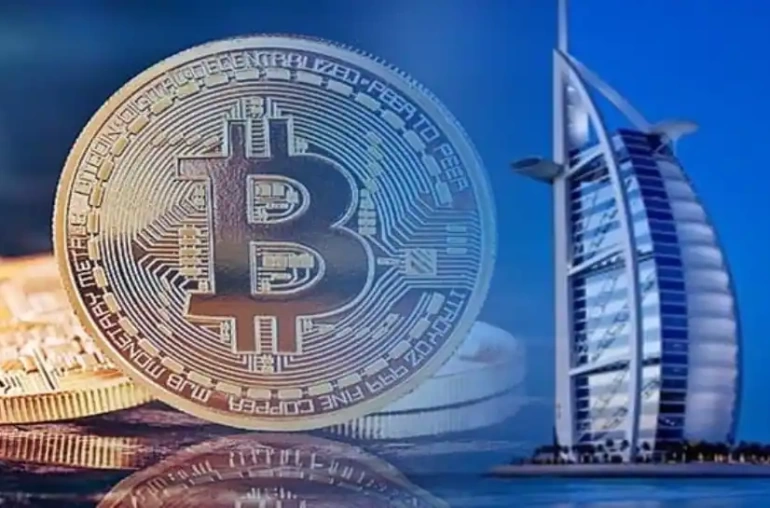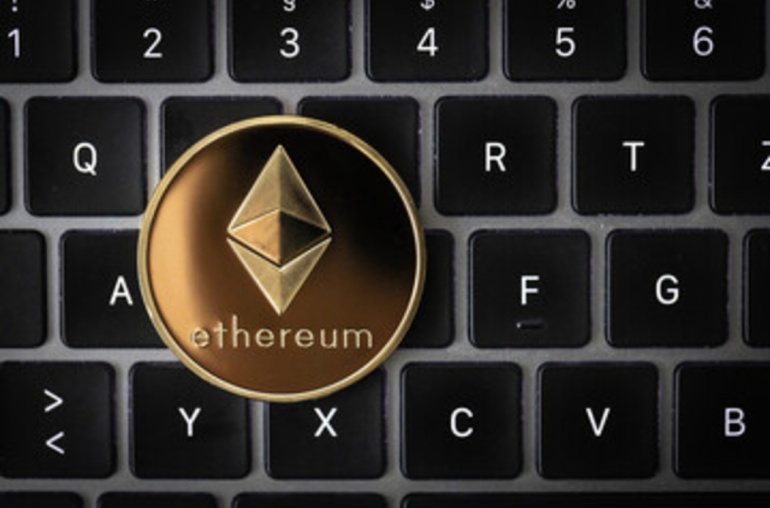The latest data from ultrasound.money indicates that Ethereum has undergone monthly total deflation for the first time ever. In the past month, the outstanding number of ETH tokens have continued to decrease, with a total decline of 56955.01 pieces, valued at roughly $88.98 million. Meanwhile, the daily average, 7-day average, and 30-day average Ethereum supply were notably negative, which led to ETH entering the deflation stage. After merely 41 days since the completion of the Ethereum network merge, the total gain is about 1330.46 ETH, which is around 80.4% of the total daily issuance of 1654.06 ETH.
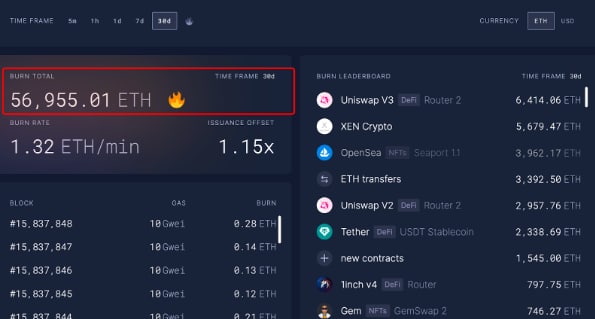
Data source:https://ultrasound.money/
Since EIP-1559 was activated on the Ethereum mainnet on August 5, 2021, all transactions on the ETH blockchain have been burning a certain amount of ETH tokens. According to available data from ultrasound.data, ETH tokens burned yesterday totaled around 2,066.29 ETH , significantly exceeding the daily issuance of 1,654.06 ETH.
Should this burning rate remain steady, then the ETH network would burn 768,000 units per year, or 24.88% of the current annual increase of 615,000 pieces, with an annual deflation rate of around 0.1%.
Data from Dune Analytics shows that, as of October 27, 2022, it can be confirmed that the total destruction of ETH has managed to surpass 2,691,277.27 pieces, worth approximately $4.2 billion. The EIP-1559 proposal that was a major part of the Ethereum London upgrade has become considerably more effective with the passage of time.

Data Source: Dune Analytics
These developments suggest there’s a fairly large amount of destruction benefits seen from the active application ecology on the ETH chain. As per ultrasound. money data, the most ETH tokens burned is on the transfer process via the Ethereum mainnet, with a total of 245,625.09 ETH taken out of the circulating supply. Meanwhile, the second is OpenSea, which has now reportedly destroyed about 230,050.14 ETH; the third is Uniswap V2, with an aggregate of 140,430.63 ETH burned. These networks are followed by Tether, Uniswap V3, Otherdeed, Metamask, and various other platforms.
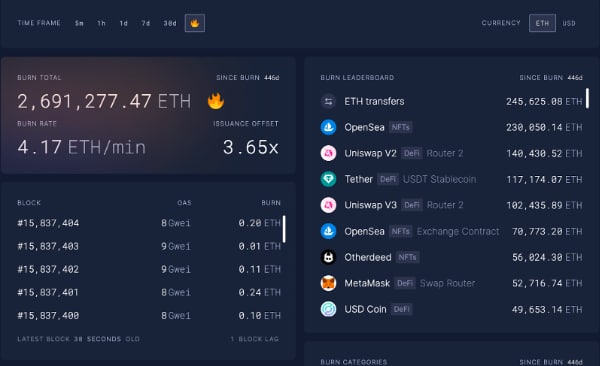
Data Source:https://ultrasound.money/
It should not be too difficult to see from these substantial ETH token burn rankings that the so-called hotspots of the Ethereum ecosystem in the last few months have focused on transactions, NFTs or digital collectibles, DeFi, and stablecoins – which are digital assets pegged to major fiat currencies like the US dollar or the British pound.
Although the Ethereum (ETH) ecosystem is growing steadily, the L2 ecosystem has also been maturing at an impressive pace. Data from L2BEAT shows that, as of October 27, the total hedging of Ethereum L2 was well over $5 billion.
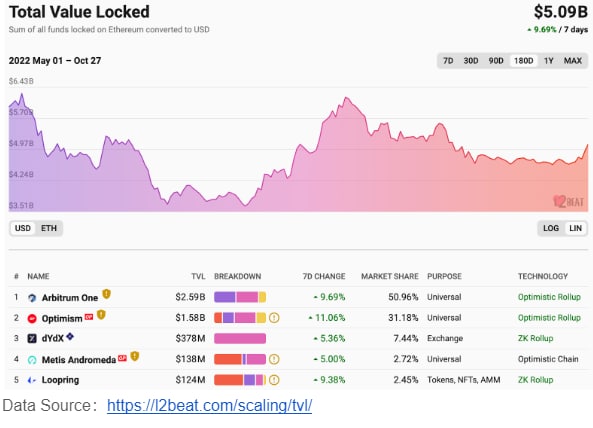
Data Source:https://l2beat.com/scaling/tvl/
It’s worth noting that Arbitrum One currently has the highest hedging volume expansion plan, with a TVL (or total-value-locked) of around $2.59 billion, accounting for a little over 50; followed by Optimism, with a TVL of about $1.58 billion, accounting for over 31%; meanwhile, dYdX has ranked third with a TVL of $378 million, accounting for over 7%.
Only few days ago, XEN Crypto (XEN), a multi-chain mining protocol on the main network, had ranked first in terms of ETH token burns for a few days following its official launch, with a total or aggregate consumption of more than 4491.03 ETH, accounting for around 26.9% of the 7-day total burn of Ethereum tokens.
With the implementation of the L2 expansion plan and the steady growth of TVL, it is now expected to bring several new growth points to the Ethereum ecosystem. It’s also quite possible that we’ll see more applications being launched, which could result in community FOMO, and this may help ETH further accelerate deflation.
As the Ethereum blockchain ecosystem becomes more widely-adopted and the upcoming deflation continues, the market is significantly raising its expectations. According to an update from The Block, Fidelity Digital Assets, which serves as an independent subsidiary of financial services company Fidelity Investments, will start offering institutional clients the service of buying, selling, and sending ETH beginning on October 28, 2022. This also confirms that institutional investors are fairly optimistic about the future market outlook of Ethereum, the world’s second-largest cryptocurrency platform by market cap and overall adoption.
After ETH announced the completion of The Merge on September 15, 2022, the price of the secondary market has been declining all the way. Just 42 days of consolidation, and now it finally regained its lost ground. According to MEXC market data, the ETH price was $1,561.66 on October 27, 2022, with a sizable gain of 24.88% after just 7 days, and the price has now returned to its initial levels.
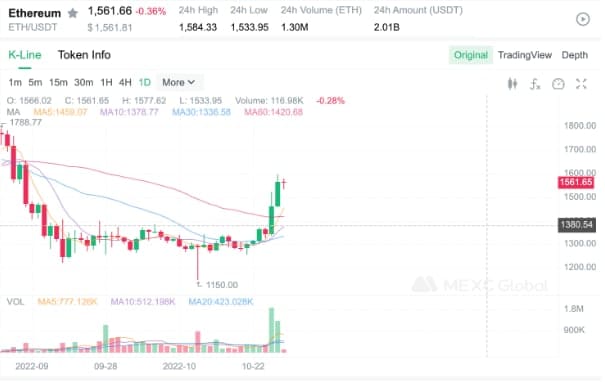
Previously, some blockchain and crypto industry insiders had predicted that the market value of ETH would surpass that of Bitcoin (BTC). However, the present market value of ETH in circulation is $191.396 billion, which is really quite far from the market value of BTC of $434.875 billion.
Now, with the ongoing improvement of ETH deflation and the development of L2 solutions, more consumers and investors are starting to see the future value of the Ethereum network and ecology and also begin to focus on ETH as an investment at the present stage. Let’s just wait and see whether ETH is able to break the historical record in the bull market that awaits us all.


